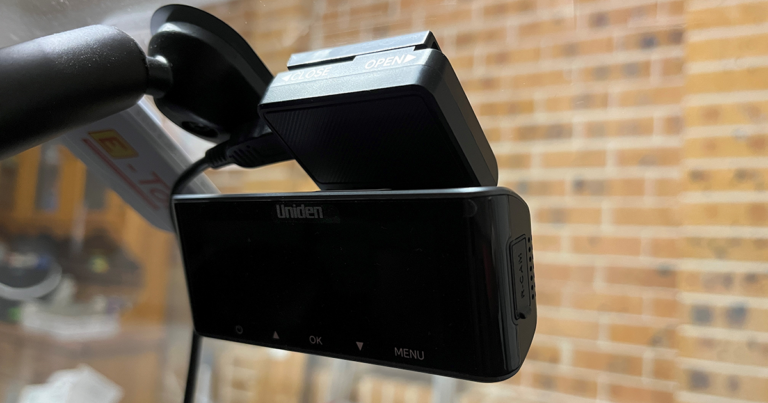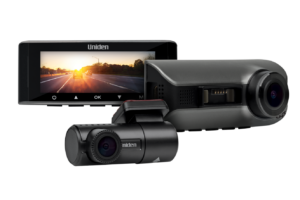iGO, uGO, we all GO.
Uniden iGO Cam 90R dash cam review
In recent years, dash cams have transitioned from nice-to-have gadgets to complete necessities for many Aussie drivers. Why? Well, most dash cams on the market right now don’t just record the driver’s view. They can also record rear or even internal footage, track GPS locations, display speedometer readings, and issue speed camera alerts, just to name a few. As is the case with most tech buys, the more cash you drop on a dash cam, the more of these features you get–and that’s the case with the Uniden iGO Cam 90R, which comes with just about all of the above.
Though it isn’t the cheapest dash cam around, the Uniden iGO Cam 90R represents excellent value for money.
Uniden iGO CAM 90R price
Dash cams can cost anywhere between $100 and $600, though the median hovers around the $300 mark. With an RRP of $349.95, the Uniden iGO CAM 90R is just on the pricier end of the spectrum. That said, considering it also includes a rear camera and other higher-end features, that price is more than justified.
If you don’t think you need a rear camera, the Uniden iGO CAM 90 (no R) is exactly the same dash cam, simply without the rear cam included. It retails for $299.95.
What's in the box?
Along with the main dash cam unit itself, the Uniden iGO CAM 90R comes with a full HD rear camera, a sticker mount bracket for each camera, a cable to connect the two, and a USB car charger.
As is the case with most dash cam brands, Uniden doesn’t throw in a microSD card—you’ll have to pay extra for a dash cam-grade microSD. Our go-to is the Sandisk High Endurance which starts at $12.80 for a 32GB card.
Likewise, if you want to hardwire the dash cam to your car, you’ll need to fork out another $49.95 for the Uniden hardwire kit.
Uniden iGO CAM 90R setup
The Uniden iGO CAM 90R is a plug-and-play affair, so installation is a cinch—the hardest part is deciding on where to place it. Since it functions as both a dash cam and a rear-view cam, it makes sense to place it somewhere with the screen visible to the driver, but not anywhere too intrusive. Initially, I placed the unit in the centre of my windscreen, close to the dashboard, but ended up nestling it behind the rear-view mirror so it was completely hidden from view. Positioning is a matter of personal preference as well as optimal camera view, so try a few spots before peeling that 3M adhesive and committing.

The mount connects to the camera magnetically, allowing for easy removal whenever you need to retrieve the microSD card or adjust the settings. It holds incredibly strongly, so you won’t need to worry about it falling off in the event of an impact and missing the important details.
If installing the rear camera, again, it’s as simple as plugging the looooong mini USB cable (included) from the main dash cam to the rear unit. You’ll want to use some sort of cable management hooks to keep the cable out of the way. Once the two cameras are connected, once you start your car and the camera turns on, you should see your front view on the left side of the display, with your rear view on the right.
Uniden iGO CAM 90R features and performance
The key thing to look for when shopping for a dash cam is camera quality and viewing angle, and the Uniden iGO CAM 90R certainly delivers on the former, but doesn’t wow us when it comes to the latter. The main front-facing camera records in 4K resolution (with the option to lower the quality to 2K or HD if you want to maximise storage) while the rear camera records in 1080p (HD) only. Both offer great detail and clarity in most scenarios, including at night, though number plates are almost impossible to read when watching low-light footage back.
The front and rear camera’s 135-degree and 150-degree fields of view (respectively) and 30fps frame rate also aren’t the best we’ve ever seen, considering the similarly-priced Garmin 67W boasts a massive 180-degree viewing angle and higher 60fps frame rate, though it records at a lower 2K resolution and doesn’t include a rear camera.
Daytime footage
Night footage
Checking the footage is as easy as removing the microSD card, inserting into the included USB adaptor, and plugging it into your computer. To access any GPS information, you’ll need to download the Uniden Player software from their website, which, at the time of writing, is only compatible with Windows computers. Uniden also offers an iOS and Android app that can connect to your dash cam via Wi-Fi, allowing you to view, download and transfer footage.
Personally, I tend to prefer dash cams without displays, as they’re usually smaller and less distracting. However, the iGO CAM 90R’s slim 3.16-inch LCD is compact and unassuming enough that it can be hidden behind your rear-view mirror but practical enough to be given pride of place on your windshield, should you want to check your rear camera feed or the on-screen speedometer.
I also loved the inclusion of speed and red light camera alerts. Though the iGO CAM 90R doesn’t boast a full Advanced Driver Awareness System (ADAS), the inclusion of these alerts—particularly when driving in an unfamiliar area—is very welcome.
Final word
The Uniden iGO CAM 90R is a fantastic all-rounder for both dash cam newcomers and those not so new to the game. It’s easy to install, packed with features, and performs admirably. Sure, we’d love it if the night vision were just a little clearer, and the field of view could definitely be wider, but these are relatively minor drawbacks to what is otherwise a great-value, versatile dash cam.
How we reviewed the Uniden iGO CAM 90R
Our review process involved setting up and using the Uniden iGO CAM 90R over a matter of weeks. During our time with the device, we recorded hours of test footage and tinkered with the settings menus available on the unit itself (plus the connected app).
We also reviewed the footage recorded to determine whether it met expectations and conducted research into how the Uniden iGO CAM 90R compares against its closest competitors in the market when it comes to specs and value for money.


